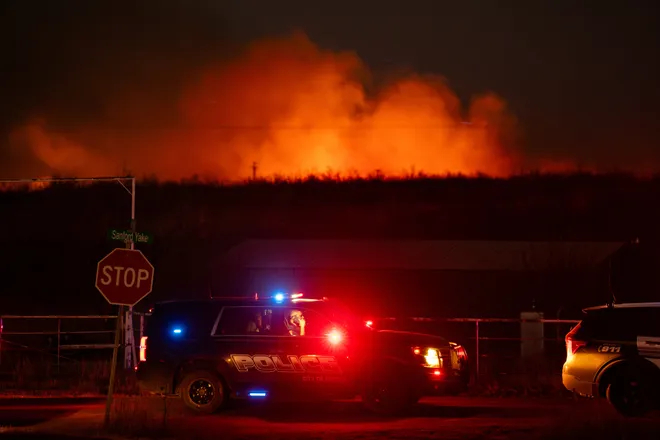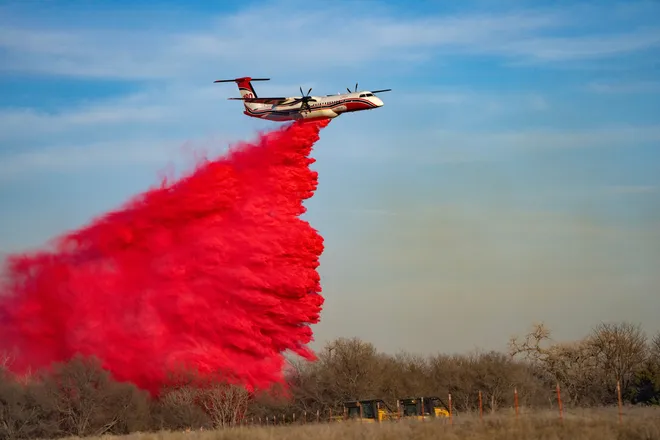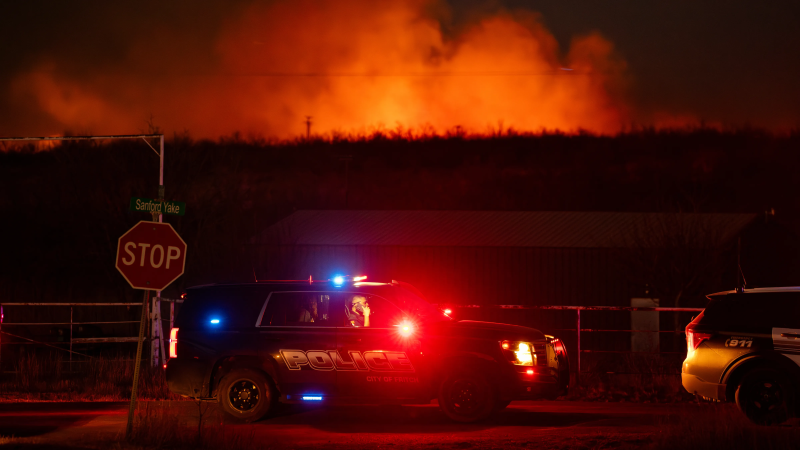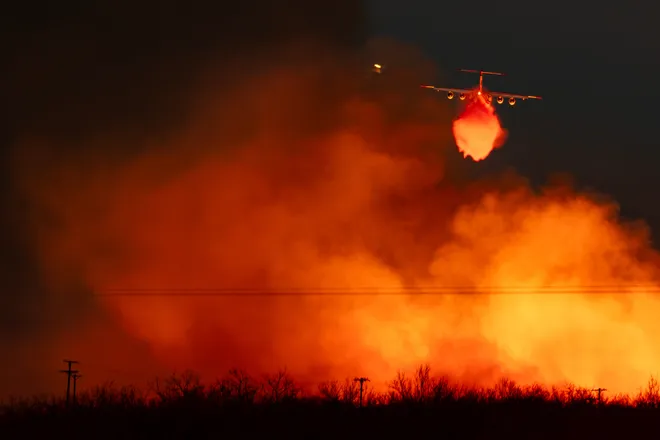Climate change helping drive an increase in large wildfires in the US
Joyce Blankenship, an 83-year-old grandmother of four, died inside her home in February when a single brush fire exploded in size in just 24 hours, racing across the landscape, burning her home and others in Stinnett, Texas.
Fueled by 50-60 mph winds and dry grasses, the fire grew so fast that it surrounded the truck of Cindy Owen, 44, where she was working more than 40 miles east of Blankenship's home. Owen was burned and died of her injuries two days later.
Dubbed the Smokehouse Creek fire, it burned across 850,000 acres in the Texas Panhandle in about 48 hours, torching more than 100 homes and killing thousands of cattle as firefighters from throughout the region battled to save homes and lives.
It would be safer for firefighters, communities and property if such massive infernos were rare, but experts say these big fires are growing even bigger and more dangerous.
“We can expect to see larger wildfires in the future,” said Seth McGinnis, associate scientist at the University Corporation for Atmospheric Research.
Such huge fires, whether ignited by natural or human causes, are fanned by factors that include the expansion of suburbia into wildlands, land management and firefighting challenges and climate change, said McGinnis and others.

While the 10-year average number of wildfires in the nation each year dropped by around 20% over the past 20 years, the average number of acres burned is up by nearly 50%, according to statistics from the National Interagency Fire Center.
Just as the rain and snow in a passing cold front ultimately helped cool down the Smokehouse Fire, the size of a wildfire is related to the duration of fire weather, McGinnis said. “Climate change is projected to increase the amount of time when high fire conditions prevail in the U.S.”
The time is coming for a reckoning and more support of firefighting efforts, said Michele Steinberg, wildfire division director at the National Fire Protection Association.
“People aren't even facing what's reality right this moment in terms of wildfire,” Steinberg said “There’s so much denial.”
Smokehouse Creek Fire one of the biggest in history
Anytime a large blaze makes headlines, people tend to compare the fire to ones of the past, but the world of fire statistics is “wacky and murky,” said Stephen Pyne, an emeritus professor at Arizona State University and an author of several books on fire history. Quantifying fires that happened more than a century ago can be "a slippery concept," Pyne said.
Using information provided by Pyne and Birgitte Messerschmidt, director of research at the fire protection association, USA TODAY put together a list of the known wildfires or wildfire complexes (groups of fires) with an estimated size of at least 500,000 acres, dating back to 1825. The list came from historical documents, state agency lists, the National Interagency Fire Center and the Western Fire Chiefs Association.
Among all those big fire complexes in history, the Smokehouse Creek Fire ranks eighth largest overall. On a list that includes only fires of at least 500,000 acres since the 1960s, when accuracy started to increase as foresters began measuring burned areas by aircraft, the Smokehouse Creek fire is the largest single fire. Only the Taylor Complex Fire in Alaska in 2004 is larger, at 1.3 million acres.
Nearly half the biggest wildfires occurred in Alaska, including seven in just the past 21 years.

Climate change is causing concern
"Climate change is leading to larger and more severe wildfires in the western United States," the latest National Climate Assessment reported last year. These fires have “significant public health, socioeconomic, and ecological implications for the nation,” the assessment reported.
Warmer temperatures create the kind of conditions that make fire behaviors more dangerous, the assessment stated.
A 2016 study, led by John Abatzoglou, concluded human-caused climate change "doubled the cumulative forest fire area since 1984" in the western U.S. In other research, Abatzoglou documented trends in warming overnight temperatures in the Pacific Northwest.
Fire scientists are working to tease apart the factors influencing large fires, to learn more about the role of climate change, land management and other human influences, McGinnis said. He points out that while climate change is "almost certainly a factor,” human activity is responsible for a lot of fire ignitions.
McGinnis is part of a National Science Foundation University of Washington-based research team studying the effects of climate change and how simultaneous large wildfires might affect firefighting.

The research team includes these findings:
- Most of the western U.S. is projected to see numbers of simultaneous, 1000+ acre fires that historically occurred once every ten years happening once every five years – or even more frequently
- The median number of large fires occurring simultaneously from July to September was about 3 times higher in 2010-2019 than it was in 1984-1993
- In Alaska, the average number of large fires during peak fire activity months approximately doubled in 2002-2019 compared to 1984-2001
Jon Keeley, a senior research scientist with the U.S. Geological Survey, said it’s important to remember climate change isn’t solely to blame for the increase in large fires.
“It’s much more complex than that,” Keeley said. As the historical lists show, there have been large fires during droughts of the past.
In California, population growth, increasing fire ignitions and the Santa Ana winds are bigger factors in wildfires, Keeley said, and don’t appear to be affected by climate change at present. Climate change is likely to be a bigger driver in the northern part of the state rather than the southern, he said.

Preparing for wildfires
Just because a fire is big doesn’t mean it’s bad, said the fire protection association's Steinberg. Big fires historically were a natural function, to clean the forest floor, put nutrients back into the soil and promote wildflower blooming, all part of healthy ecosystems adapted to fire over thousands of years. Indigenous peoples also used fire to maintain healthy habitats.
The problem arises when houses are in the way.
“When we talk about the rise of wildfire disasters, by that I mean homes and neighborhoods being obliterated by fire,” Steinberg said. "We’ve got fire on the landscape and then we’ve got all this built environment, frankly in the way, and it’s largely not designed to withstand anything like the impacts we’re seeing.”
On top of those concerns, Steinberg said fire departments are concerned about their ability to safely fight the large, dangerous blazes, especially in situations like Texas when several large wildfires all pop up in the same region at the same time.
Every five years, the association surveys firefighters about the needs of the 26,000 or so fire departments across the nation. Many are largely staffed by volunteers, and Steinberg said about two-thirds say they lack training and/or personal protective equipment and gear to fight fires safely and successfully.
“That’s a terrifying proportion, that we’re putting the firefighters lives on the line,” she said. “There’s a very huge lack of recognition of that problem and it’s only going to continue.”
Dinah Voyles Pulver covers climate and the environment for USA TODAY. Reach her at dpulver@gannett.com or @dinahvp.
Disclaimer: The copyright of this article belongs to the original author. Reposting this article is solely for the purpose of information dissemination and does not constitute any investment advice. If there is any infringement, please contact us immediately. We will make corrections or deletions as necessary. Thank you.

